Voltage Distribution and Flashover Performance of 220 kV Composite Insulators under Different Icing Conditions
Abstract
1. Introduction
- Secondly, the composite insulators’ experimental results are presented and analyzed in Section 3. Equivalent circuit models are built, effects of the booster sheds and ZnO resistors on the iced insulators’ voltage distributions and flashover performance are discussed. As compared with the dynamic models in the existing studies [7,8,9,10,11,14], the equivalent circuits presented in this paper are used for voltage distribution analysis in steady state, and the effects of ZnO resistors are considered when building the equivalent circuit models.
- Finally, Section 4 gives the conclusions. References are proposed for the design of outdoor composite insulators in cold climate regions.
2. Test Facilities, Specimens and Procedures
2.1. Test Facilities
2.2. Test Specimens
2.3. Test Procedures
2.3.1. Ice Accumulation Method
2.3.2. Parameter Defining Ice Degree
2.3.3. Electric and Flashover Performance Evaluation Methods
3. Test Results and Analysis
3.1. Test Results
- (1)
- With the increasing of icing degree, the flashover voltages decrease and tend to saturation.
- (2)
- When icing degree is light (d = 5 mm), the icing flashover voltages of insulators with more booster sheds are higher. However, with the increasing of ice thickness (d ≥ 15 mm), excessive booster sheds can lead to lower flashover voltages (type E). When d = 25 mm, the flashover voltages of the test specimens are very close to each other.
3.2. Influence of Booster Sheds on Flashover Path and U50
- (1)
- For type A, partial arcs appeared at the top and bottom terminals and blue corona discharges appeared at the middle part of the insulator. As the flashover process went on, partial arcs are developed through the whole insulator, leading to icing flashover to happen.
- (2)
- For the test insulators with booster sheds (type C), partial arcs appeared at the air gaps between the icicles of the booster sheds and ordinary sheds. As the applied voltage was increased, the partial arcs between the air gaps developed through the whole insulator, and flashover happened.
- (1)
- When d = 5 mm, as shown in Figure 8a, the icing degree is light and the insulator sheds are not bridged by icicles. Insulator with more booster sheds has a longer creep distance and longer air gap length on the flashover path, leading to higher flashover voltage.
- (2)
- When d = 15 mm, as shown in Figure 8b, the small and middle insulator sheds are all bridged by icicles. The flashover path is determined by the shortest air gap length, either the gap length between the icicles of the booster sheds and middle sheds (L1) or the gap length of the icicle below the booster sheds (L2). It is confirmed that, for type B to type D, flashovers happen along L1, more booster sheds can increase the number of air gaps and improve insulators’ icing flashover performance. However, when there are excessive booster sheds on the test specimens (type E), the distance between the booster sheds become shorter, and flashovers may happen along L2 (L2 < L1), leading to shorter air gap lengths and lower flashover voltages. According to the test results, the optimized booster sheds number should be chosen as 5 for the test specimens in this paper.
- (3)
- When d = 25 mm, as shown in Figure 8c, the small, middle, and booster sheds of the test specimens are all bridged by icicles. The flashover voltages of the test specimens are very close to each other.
3.3. Influence of ZnO Resistors on Voltage Distribution
- (1)
- When d = 5 mm (Figure 9a), the air gaps near the high-voltage terminal and under the booster sheds withstand more voltage than other parts. However, the small and middle sheds are not all bridged by icicles, there is still a small part of voltage that is applied on the small and middle sheds. For Type D, the voltage applied on each air gap are very close to each other. For type F, because of the ZnO resistors, the voltage applied on the insulator part is 38 kV, and the voltage applied on the arrester part is 12 kV.
- (2)
- When d = 15 mm (Figure 9b), the small and middle sheds are all bridged. The air gaps near the high-voltage terminal and under the booster sheds withstand more than 90% of the applied voltage. For type F, with the increasing of ice thickness, more voltage (21 kV) is applied on the arrester part.
- (3)
- When d = 25 mm (Figure 9c), all the insulator sheds are bridged by icicles, the applied voltage is distributed uniformly on the insulators. For type F, the arrester part withstands nearly 50% (27 kV) of the applied voltage.
4. Conclusions
- (1)
- From the comparison of the icing flashover performance of the iced insulators with different sheds configurations, it can be known that the booster sheds number should be chosen as 5, and the booster sheds should be uniformly distributed on the insulators.
- (2)
- From the comparison of voltage distributions and icing flashover performance of type D and type F, it can be known that the ZnO resistors contained in the composite insulators may decrease the voltage required to initiate corona and partial arcs under light or moderate icing conditions, but the flashover voltages are influenced little by the ZnO resistors. So, type F insulator can be used in regions where icing and lightning frequently happen.
Acknowledgments
Author Contributions
Conflicts of Interest
References
- Ren, A.; Liu, H.S.; Wei, J.C.; Li, Q.Q. Natural Contamination and Surface Flashover on Silicone Rubber Surface under Haze–Fog Environment. Energies 2017, 10, 1580. [Google Scholar] [CrossRef]
- Lv, Y.; Zhao, W.; Li, J.; Zhang, Y. Simulation of Contamination Deposition on Typical Shed Porcelain Insulators. Energies 2017, 10, 1045. [Google Scholar] [CrossRef]
- Farzaneh, M.; Kiernicki, J. Flashover problems caused by ice build-up on insulators. IEEE Electr. Insul. Mag. 1995, 11, 5–17. [Google Scholar] [CrossRef]
- Li, P.; Fan, J.; Li, W.; Su, Z.; Zhou, J. Flashover Performance of HVDC Iced Insulator Strings. IEEE Trans. Dielectr. Electr. Insul. 2007, 14, 1334–1338. [Google Scholar] [CrossRef]
- Hu, J.L.; Jiang, X.L.; Yin, F.H.; Zhang, Z.J. DC Flashover Performance of Ice-Covered Composite Insulators with Parallel Air Gaps. Energies 2015, 8, 4983–4999. [Google Scholar] [CrossRef]
- Liu, Y.; Gao, S.; Huang, D.; Yao, T.; Wu, X.; Hu, Y.; Cai, W. Icing flashover characteristics and discharge process of 500 kV AC transmission line suspension insulator strings. IEEE Trans. Dielectr. Electr. Insul. 2010, 17, 434–442. [Google Scholar] [CrossRef]
- Taheri, S.; Farzaneh, M.; Fofana, I. Equivalent surface conductivity of ice accumulated on insulators during development of AC and DC flashovers arcs. IEEE Trans. Dielectr. Electr. Insul. 2013, 20, 1789–1798. [Google Scholar] [CrossRef]
- Taheri, S.; Farzaneh, M.; Fofana, I. Empirical flashover model of EHV post insulators based on ISP parameter in cold environments. IEEE Trans. Dielectr. Electr. Insul. 2016, 23, 403–409. [Google Scholar] [CrossRef]
- Fofana, I.; Farzaneh, M. Application of Dynamic Model to Flashover of Ice-covered Insulators. IEEE Trans. Dielectr. Electr. Insul. 2007, 14, 1410–1417. [Google Scholar] [CrossRef]
- Fofana, I.; Farzaneh, M.; Hemmatjou, H.; Volat, C. Study of discharge in air from the tip of an icicle. IEEE Trans. Dielectr. Electr. Insul. 2008, 15, 730–740. [Google Scholar] [CrossRef]
- Farzaneh, M.; Volat, C.; Zhang, J. Role of air gaps on AC withstand voltage of an ice-covered insulator string. IEEE Trans. Dielectr. Electr. Insul. 2006, 13, 1350–1357. [Google Scholar] [CrossRef]
- Taheri, S.; Farzaneh, M.; Fofana, I. Influence of air gaps on the DC withstand voltage of ice-covered UHV insulators. In Proceedings of the 2012 Annual Report Conference on Electrical Insulation and Dielectric Phenomena (CEIDP), Montreal, QC, Canada, 14–17 October 2012; pp. 745–748. [Google Scholar] [CrossRef]
- Farzaneh, M.; Fofana, I.; Tavakoli, C.; Chen, X. Dynamic modeling of DC arc discharge on ice surfaces. IEEE Trans. Dielectr. Electr. Insul. 2003, 10, 463–474. [Google Scholar] [CrossRef]
- Taheri, S.; Farzaneh, M.; Fofana, I. Dynamic modeling of AC multiple ARCS of EHV post station insulators covered with ice. IEEE Trans. Dielectr. Electr. Insul. 2015, 22, 2014–2023. [Google Scholar] [CrossRef]
- Ndiaye, I.; Farzaneh, M.; Fofana, I. Study of the Development of Positive Streamers along an Ice Surface. IEEE Trans. Dielectr. Electr. Insul. 2007, 14, 1436–1445. [Google Scholar] [CrossRef]
- Hu, J.; Sun, C.; Jiang, X.; Xiao, D.; Zhang, Z.; Shu, L. DC Flashover Performance of Various Types of Ice-Covered Insulator Strings under Low Air Pressure. Energies 2011, 5, 1554–1576. [Google Scholar] [CrossRef]
- Ale-Emran, S.M.; Farzaneh, M. Flashover performance of ice-covered post insulators with booster sheds using experiments and partial arc modeling. IEEE Trans. Dielectr. Electr. Insul. 2016, 23, 979–986. [Google Scholar] [CrossRef]
- Ale-Emran, S.M.; Farzaneh, M. Dimensioning of booster sheds for icing protection of post station insulators. IEEE Trans. Dielectr. Electr. Insul. 2014, 21, 2576–2583. [Google Scholar] [CrossRef]
- Ale-Emran, S.M.; Farzaneh, M. Parametric studies and improved hypothesis of booster-shed effects on post insulators under heavy icing conditions. IEEE Trans. Dielectr. Electr. Insul. 2015, 22, 420–427. [Google Scholar] [CrossRef]
- Deng, Y.; Jia, Z.; Zhou, J.; Sun, L. Ice Flashover Performance and Its Characterization Parameter of Composite Insulator with Booster Sheds. IEEE Trans. Dielectr. Electr. Insul. 2016, 23, 1021–1029. [Google Scholar] [CrossRef]
- Shu, L.; Wang, S.; Jiang, X.; Hu, Q.; He, Y.; Wu, Z. Influences of grading ring arrangement on AC flashover performance of 220 KV ice-covered composite insulators. IEEE Trans. Dielectr. Electr. Insul. 2016, 21, 2652–2661. [Google Scholar] [CrossRef]
- Lu, J.; Zhao, C.; Jiang, Z.; Xie, P.; Hu, J. Simulation and experiment of a composite insulator with lightning protection and icing flashover prevention. In Proceedings of the International Conference on Lightning Protection (ICLP), Shanghai, China, 11–18 October 2014; pp. 1987–1991. [Google Scholar] [CrossRef]
- Hu, Q.; Shu, L.; Jiang, X.; Sun, C.; Zhang, Z.; Hu, J. Effects of shed configuration on AC flashover performance of ice-covered composite long-rod insulators. IEEE Trans. Dielectr. Electr. Insul. 2012, 19, 200–208. [Google Scholar] [CrossRef]
- Yin, F.; Jiang, X.; Farzaneh, M.; Hu, J. Electrical performance of 330-kV composite insulators with different shed configurations under icing conditions. IEEE Trans. Dielectr. Electr. Insul. 2015, 22, 3395–3404. [Google Scholar] [CrossRef]
- Koch, R.E.; Timoshenko, J.A.; Anderson, J.G.; Shih, C.H. Design of Zinc Oxide Transmission Line Arresters for Application on 138 kV Towers. IEEE Trans. Power Apparatus Syst. 2675, PAS-104, 2675–2680. [Google Scholar] [CrossRef]
- IEEE Std. 1783-2009, IEEE Guide for Test Methods and Procedures to Evaluate the Electrical Performance of Insulators in Freezing Conditions; Institute of Electrical and Electronics Engineers, Inc.: New York, NY, USA, 2009.
- Farzaneh, M.; Drapeau, J.F. AC flashover performance of insulators covered with artificial ice. IEEE Trans. Power Deliv. 1995, 10, 1038–1051. [Google Scholar] [CrossRef]
- Hu, Q.; Wang, S.; Shu, L.; Jiang, X.; Liang, J.; Qiu, G. Comparison of AC Icing Flashover Performances of 220 kV Composite Insulators with Different Shed Configurations. IEEE Trans. Dielectr. Electr. Insul. 2016, 12, 995–1004. [Google Scholar] [CrossRef]
- Yang, Q.; Wang, R.; Sima, W.; Jiang, C.; Lan, X.; Markus, Z. Electrical Circuit Flashover Model of Polluted Insulators under AC Voltage Based on the Arc Root Voltage Gradient Criterion. Energies 2012, 5, 752–769. [Google Scholar] [CrossRef]
- Hu, J.; Sun, C.; Jiang, X.; Yang, Q.; Zhang, Z.; Shu, L. Model for Predicting DC Flashover Voltage of Pre-Contaminated and Ice-Covered Long Insulator Strings under Low Air Pressure. Energies 2011, 4, 628–643. [Google Scholar] [CrossRef]
- Liu, Y.; Farzaneh, M.; Du, B. Nonlinear Characteristics of Leakage Current for Flashover Monitoring of Ice-covered Suspension Insulators. IEEE Trans. Dielectr. Electr. Insul. 2016, 23, 1242–1250. [Google Scholar] [CrossRef]
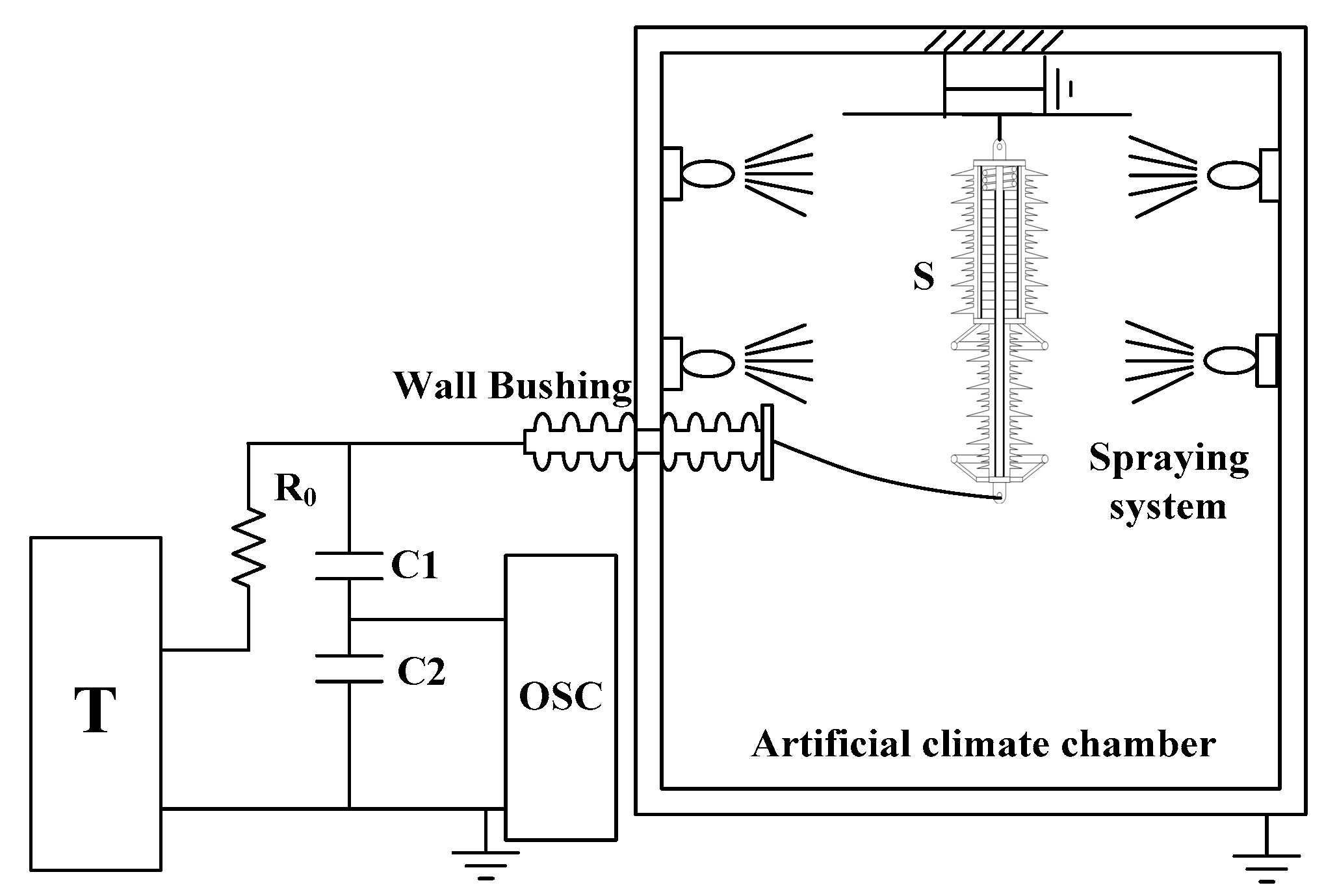
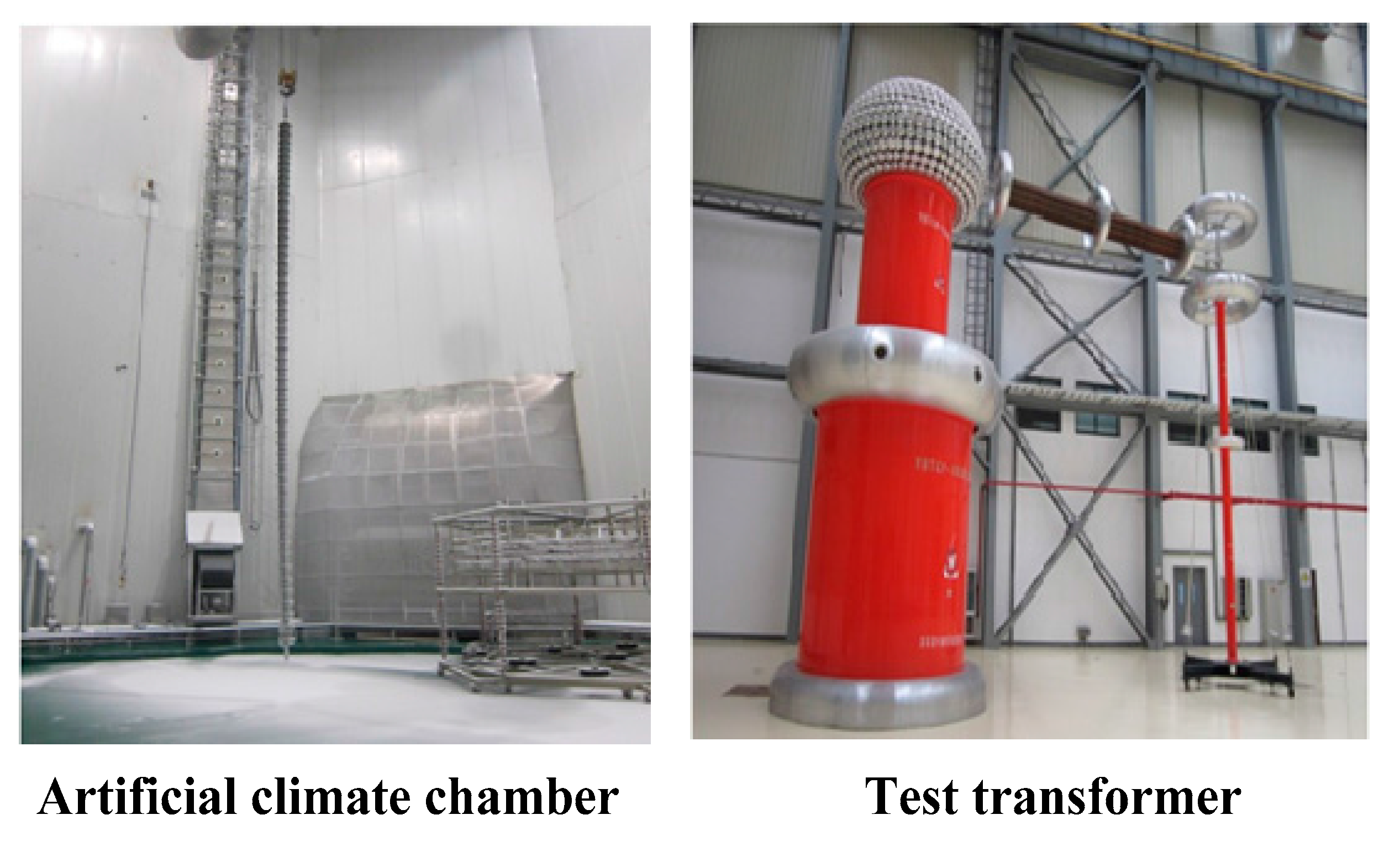
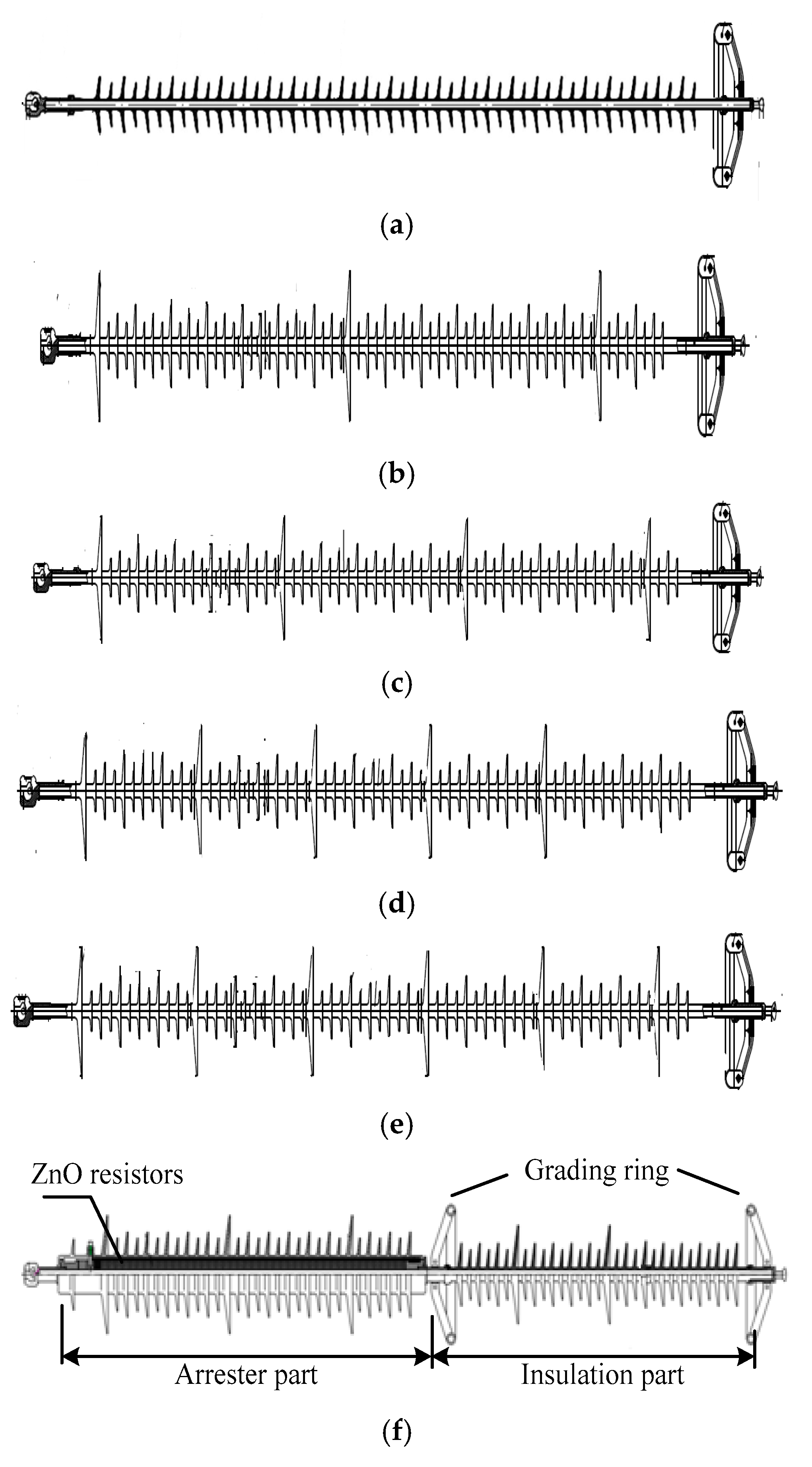
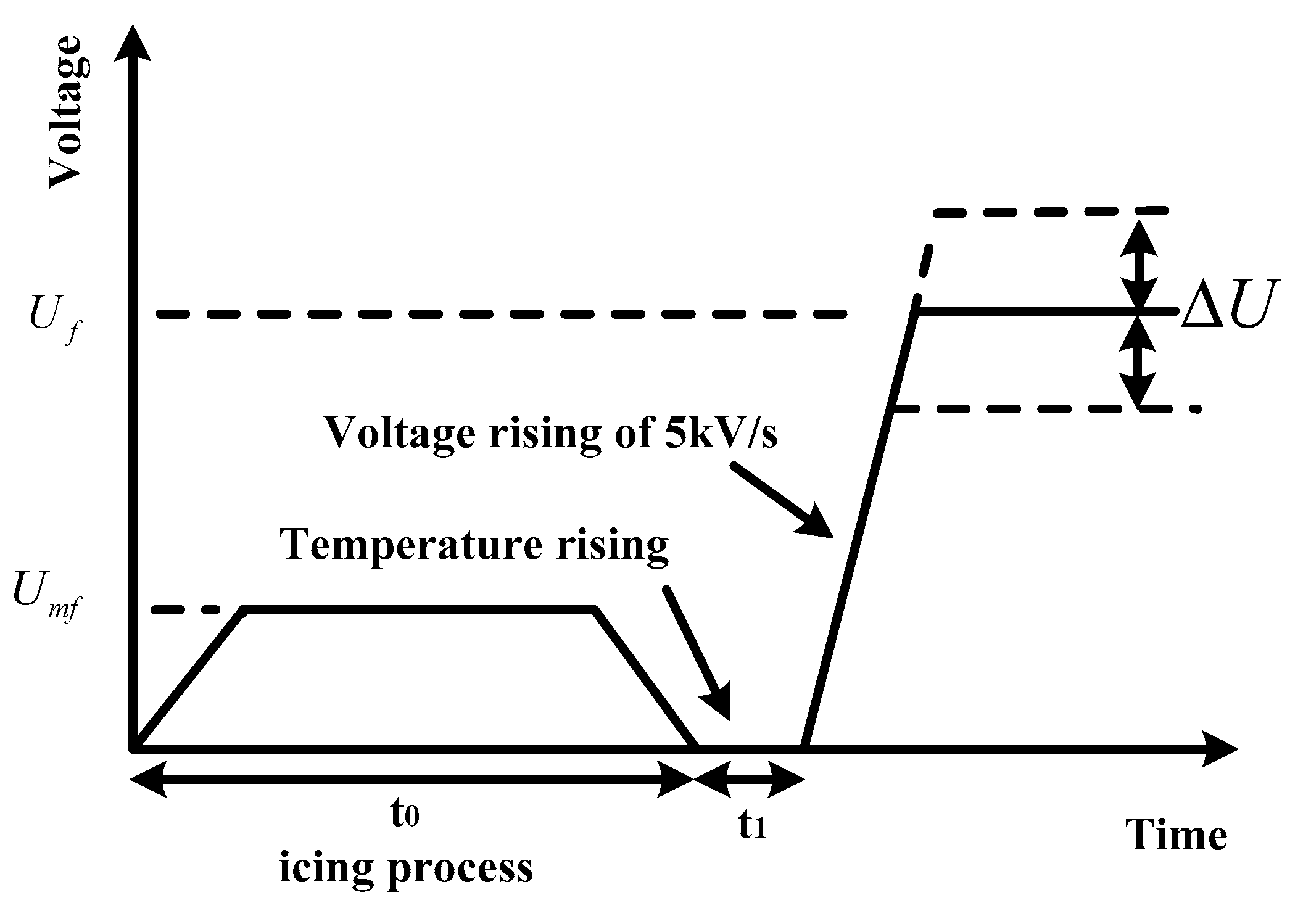
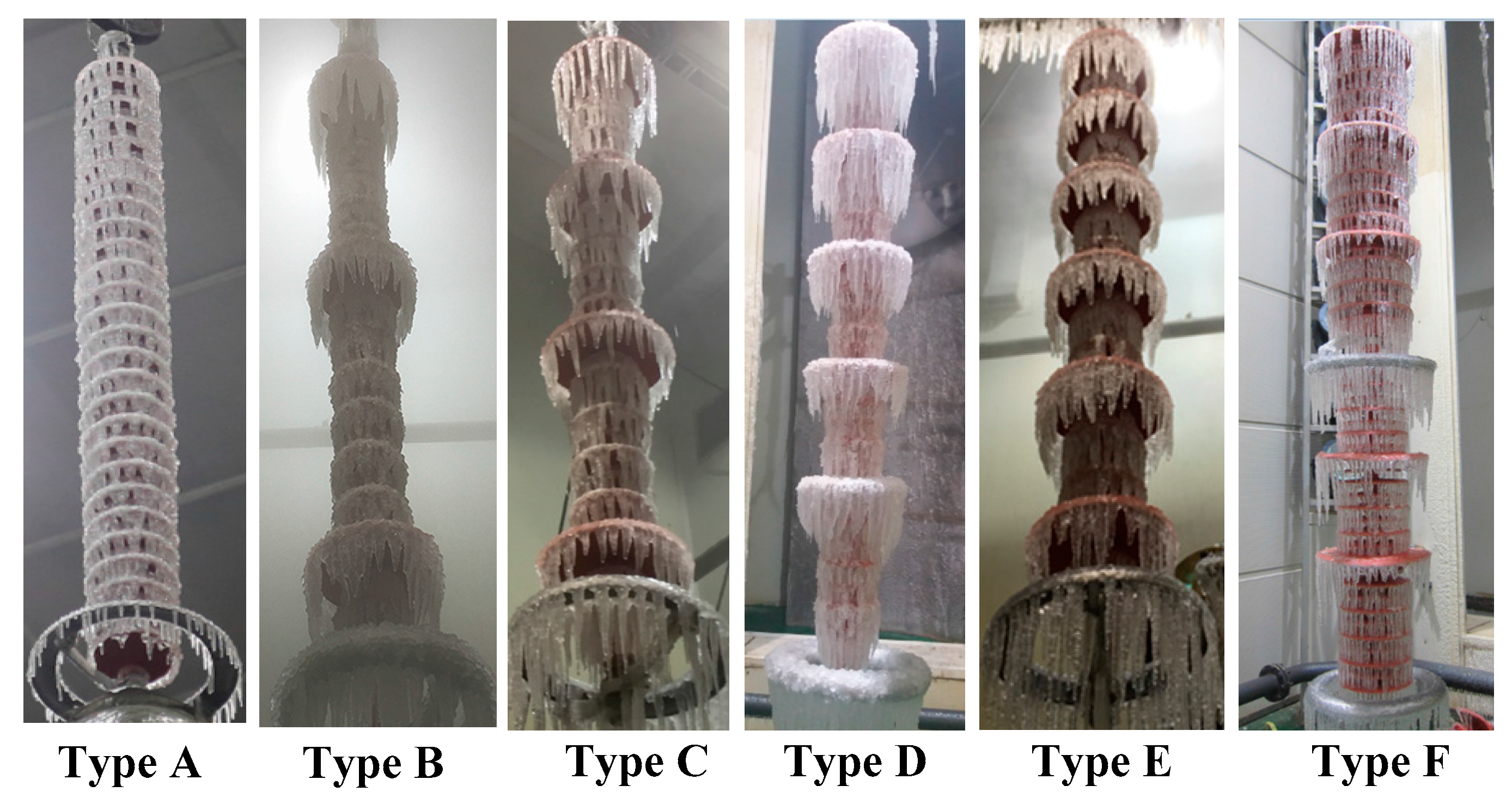

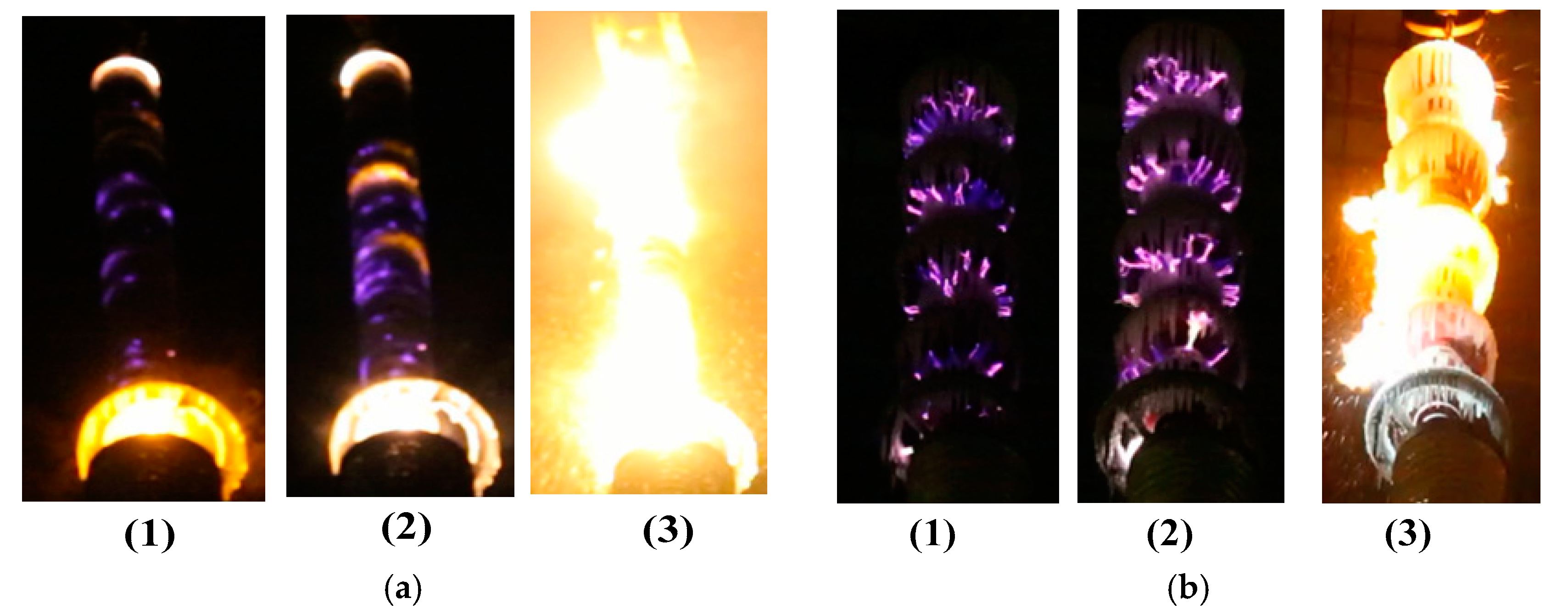
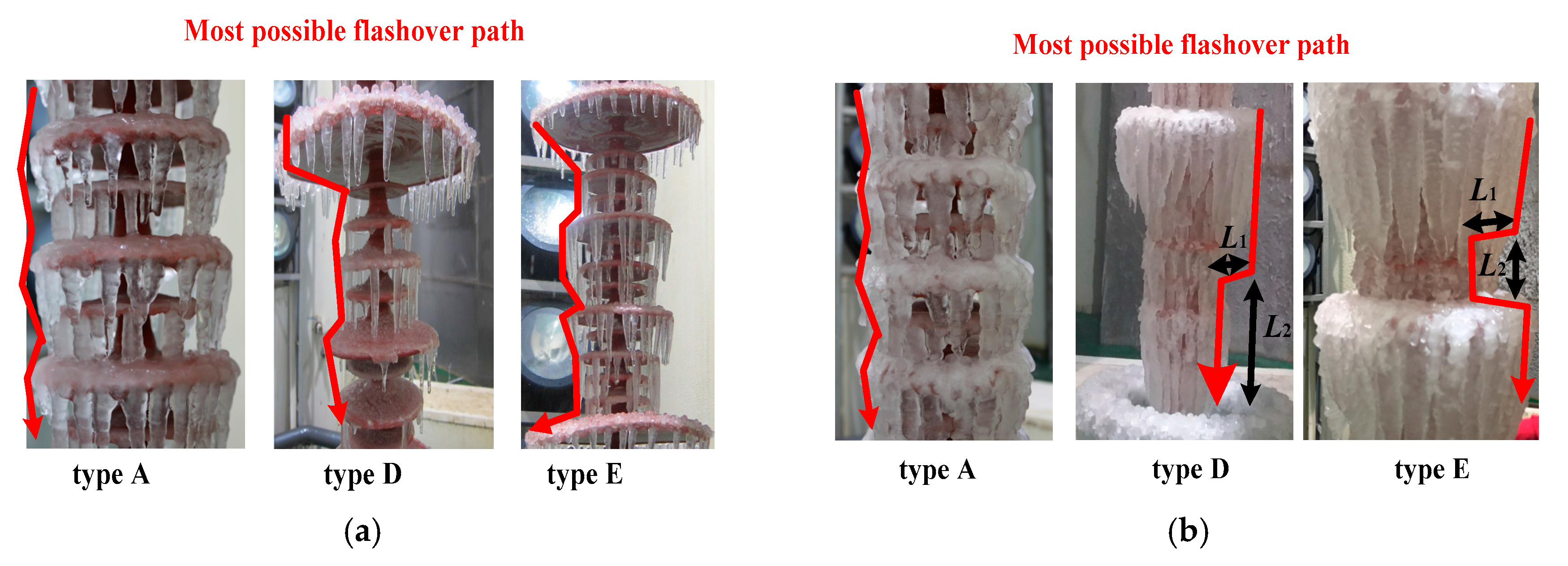



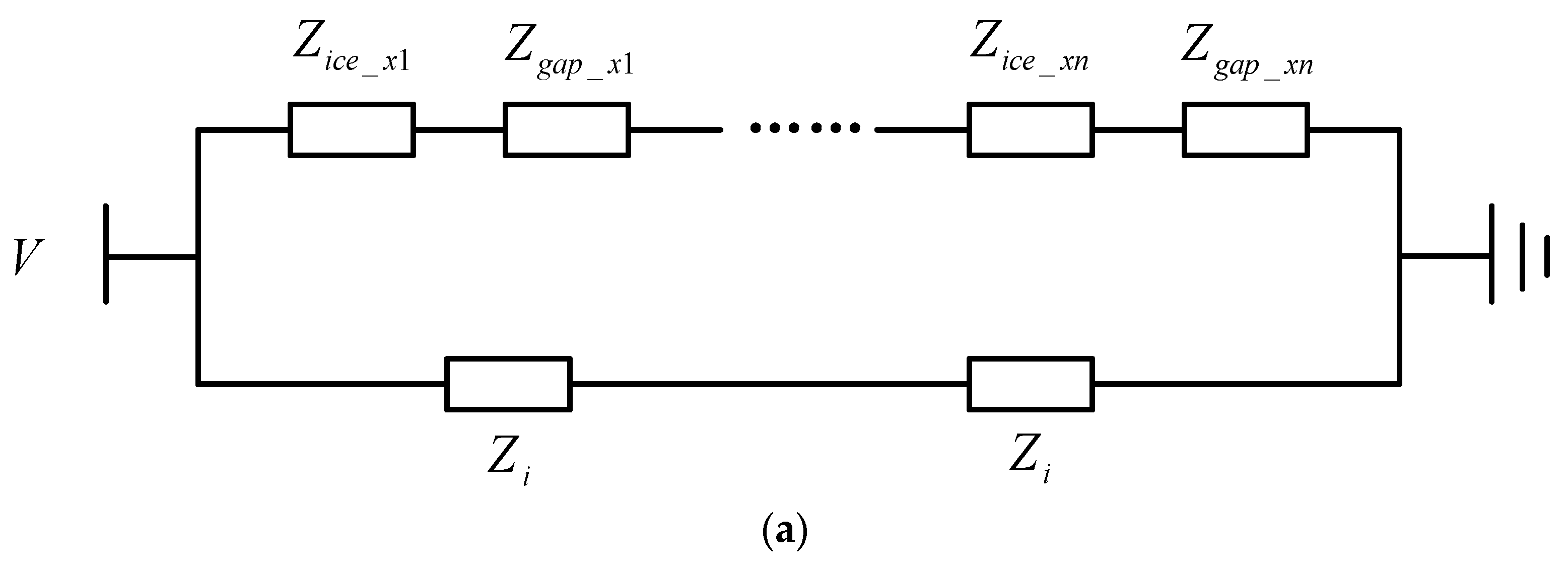

| Type | C1/C2 (mm) | dS (mm) | D1/D2/D3 (mm) | h (mm) | l (mm) | N |
|---|---|---|---|---|---|---|
| A | 34 | 35 | 140/115 | 2240 ± 30 | 5040 | 0 |
| B | 34 | 35 | 250/140/78 | 2240 ± 30 | 5505 | 3 |
| C | 34 | 35 | 250/140/78 | 2240 ± 30 | 5970 | 4 |
| D | 34 | 35 | 250/140/78 | 2240 ± 30 | 6435 | 5 |
| E | 34 | 35 | 250/140/78 | 2240 ± 30 | 6900 | 6 |
| F | 34/135 | 35 | 300/216/186 246/160/126 | 2240 ± 20 | 6600 | 5 |
| Ambient air temperature (°C) | −10–−8 |
| Water droplet size (μm) | 80–120 |
| Freezing water conductivity (μS/cm) at 20 °C | 370 |
| Wind velocity (m/s) | 3 |
| Water flux (l/h·m2) | 60 ± 20 |
| d (mm) | Type A | Type B | Type C | Type D | Type E | Type F |
|---|---|---|---|---|---|---|
| 5 | 212 | 230 | 254 | 275 | 290 | 277 |
| 10 | 183 | 195 | 214 | 227 | 231 | 222 |
| 15 | 163 | 182 | 188 | 197 | 193 | 198 |
| 20 | 154 | 172 | 174 | 185 | 179 | 183 |
| 25 | 152 | 164 | 162 | 167 | 169 | 170 |
| Parameter | A | B | C | D | E | F |
|---|---|---|---|---|---|---|
| Ad | 302 | 315.7 | 412.0 | 462.3 | 506.4 | 442.1 |
| c | 0.222 | 0.203 | 0.289 | 0.312 | 0.347 | 0.296 |
© 2018 by the authors. Licensee MDPI, Basel, Switzerland. This article is an open access article distributed under the terms and conditions of the Creative Commons Attribution (CC BY) license (http://creativecommons.org/licenses/by/4.0/).
Share and Cite
Lu, J.; Xie, P.; Jiang, Z.; Fang, Z.; Wu, W. Voltage Distribution and Flashover Performance of 220 kV Composite Insulators under Different Icing Conditions. Energies 2018, 11, 632. https://doi.org/10.3390/en11030632
Lu J, Xie P, Jiang Z, Fang Z, Wu W. Voltage Distribution and Flashover Performance of 220 kV Composite Insulators under Different Icing Conditions. Energies. 2018; 11(3):632. https://doi.org/10.3390/en11030632
Chicago/Turabian StyleLu, Jiazheng, Pengkang Xie, Zhenglong Jiang, Zhen Fang, and Wei Wu. 2018. "Voltage Distribution and Flashover Performance of 220 kV Composite Insulators under Different Icing Conditions" Energies 11, no. 3: 632. https://doi.org/10.3390/en11030632
APA StyleLu, J., Xie, P., Jiang, Z., Fang, Z., & Wu, W. (2018). Voltage Distribution and Flashover Performance of 220 kV Composite Insulators under Different Icing Conditions. Energies, 11(3), 632. https://doi.org/10.3390/en11030632




